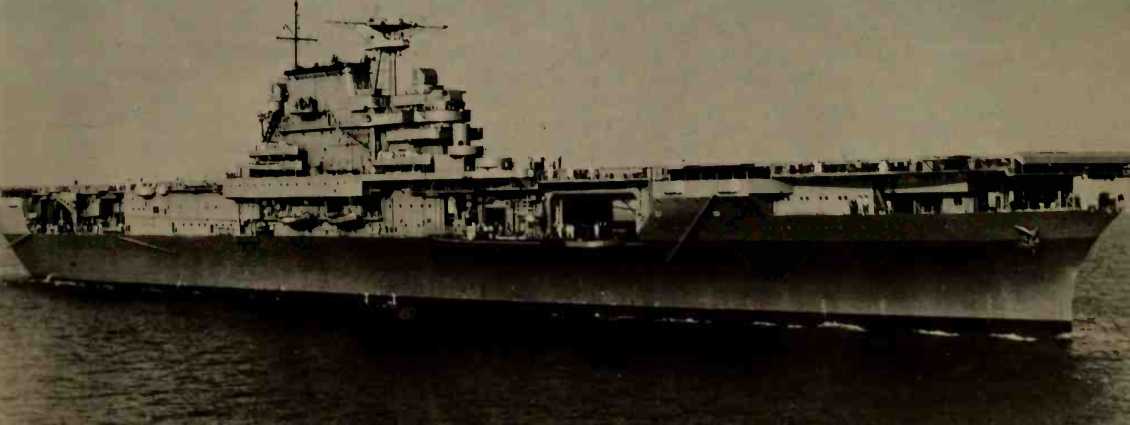In prewar days the U. S. armed forces, spearheaded by the Marine Gorps, had largely solved the problem of invading strongly defended bases. Also, though this fact was not fully recognized, the aircraft carrier had provided the means for isolating and attacking enemy bases protected by land-based air defenses. There remained the question of how to free the fleet from dependence on established bases, essentially a logis-
U. S. - fleet carrier Hornet, built as a carrier from the keel up.

Tic problem. The solution was found late, but it was found in time.
Sailing ships had been able to remain at sea for months, but with each adoption of the fruits of the industrial revolution, ships became—until the nuclear age—more dependent on land bases for fuel, ammunition, repairs, and general upkeep. A notable exception to this trend was the shift from coal to oil. Alongside-refuehng with oil, an American specialty developed after World War I, proved much simpler, quicker, and more practical than coaling at sea. Nevertheless, a steam fleet could not move far from base without provision for servicing overseas or by its own train of service vessels.
By 1941 many of the U. S. wartime problems of stepped-up manufacture, distribution, and shipping had perforce been at least partially solved in order to meet the needs of England and China. At the same time, however. Pearl Harbor, the nation’s chief Pacific naval base, was barely able to support the Pacific Fleet, and, as the Japanese raid demonstrated, it was utterly unprepared to protect the ships. After the raid brought the United States into World War II, not only were steps taken immediately to strengthen Pearl Harbor, but work on additional bases was begun at Bora Bora in the Society Islands, at Samoa, at Tongatabu in the Tonga Islands, at Efate and Espiritu Santo in the New Hebrides, at Noumea on New Caledonia, and at Auckland, New Zealand. These points were already in Allied hands, but it was obvious that as the Allies advanced westward they would have to capture Japanese positions and convert them into bases for their own use. The solution to this problem was threefold.
First was the recruiting and establishment of Construction Battalions (“Seabees”), men trained in base construction, given uniforms and some military status, taught the use of weapons, and landed with assault troops. Initially the Seabees all performed the same tasks, but they were eventually organized into such specialized groups as Base Aircraft Service Units (BASUs) and Carrier Aircraft Service Units (CASUs).
Second was the development of standardized base components, including all the materials and personnel needed to set up various sorts of bases. Groups of components were designated “Lions” for major naval bases, “Cubs” for secondary bases, and “Acorns” for naval air bases. Flexibility was achieved through the Catalogue for Advanced Base Functional Components, a kind of multivolume mail order catalogue from which base components could be ordered.
Third, and in some ways the most important, were the mobile service squadrons of Service Force Pacific, the logistic arm of the U. S. Pacific Fleet. The service squadrons were nothing less than floating bases comprising tenders, oilers, and repair and supply ships of all kinds. They moved with the fleet and dropped anchor in any suitable harbor, ready to supply and maintain the warships. Originally established at Funafuti in the Ellice Islands in October 1943, the squadrons subsequently went to work in the calm lagoons of such Central Pacific atolls as Majuro, Kwajalein, and Ulithi and in the waters of the Admiralty Islands and of Kerama Retto off Okinawa.




 World History
World History









